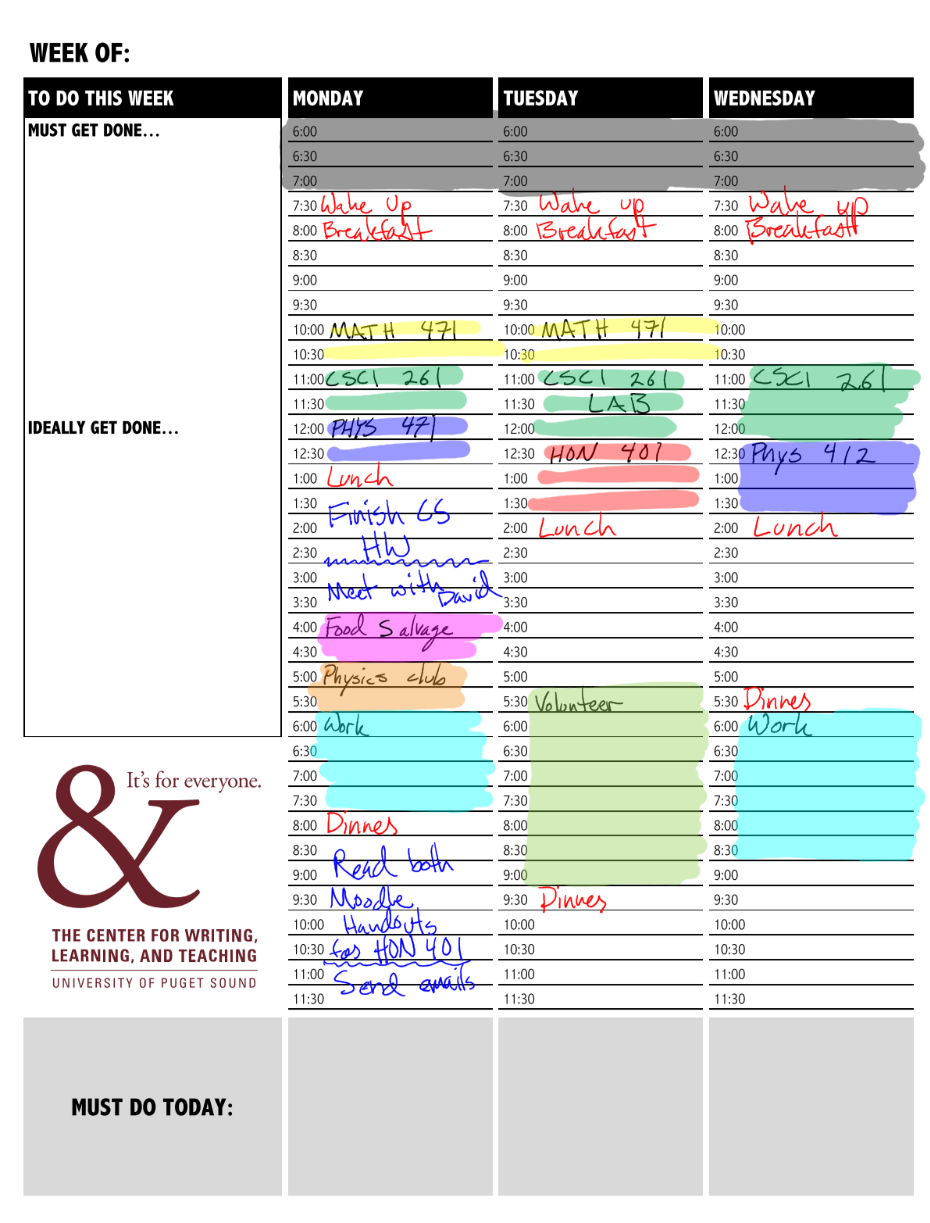Subsection 10.3.6 Making and Using a Time Chart
All right. Approach big problems with small goals. Great. But how do you then follow through on those smaller goals? As you start breaking down your bigger projects, you’ll find the strategies that work well for you, and tweaking the strategies that we recommend here to be most effective for you is important! That being said, one of the most tried-and-true approaches to managing daily work is the time chart. The point of a time chart is to give you an action plan for each day. It accounts for where you have to be when, but it also includes what work you’re going to do when. A time chart isn’t a planner or a calendar, but making a good time chart requires that you have a good sense of both what you need to do on a given day and what your time commitments are on a given day, which planners and calendars, respectively, help you keep track of. Finally, time charts are useful because they force you to assign priority to the tasks you want to accomplish.
So how should you use a time chart? As is the case with everything we’ve discussed in the academic success section, everyone develops slight variations on the underlying strategies for staying organized and managing time, but the steps we lay out here are a great way to start if you’ve never made a time chart before. Many people like to use a paper planner, which is what we present first, but there are great digital options for making a time chart as well, such as Google Calendar. First, take a look at the time chart below. .

With your own time chart in hand, fill it out following the following guidelines.
- Add all of your classes for the week.
- Add your other fixed commitments, which could include sports or music practices, work, exercise, meals, club meetings, and appointments with friends or professors.
- Look at the time that’s left, and schedule in time to work on specific goals or assignments. Remember to:
-
Be realistic about how long each task is going to take.This will be easiest if you’ve briefly looked over assignments ahead of time to triage your workload. How long are each of those readings? How many problems are in the problem-set?
-
Remember those sub-goals.Better to give yourself 2 hours to write an outline for a paper than to give yourself 8 hours to write a paper (see Subsection 10.3.5)
-
Recognize that some time is “higher quality” than other time, and use it to do your highest-priority tasks.Four hours of work during the time of day when you’re most focused is probably a much better time to work on a challenging problem set than during a one hour break between difficult classes when you’re also hungry.
-
Make time for review.Your long-term memory will remember content best if you review it right as you start to forget what you’ve learned. Taking time at the end of the day to go over class notes and remember the highlights of what you learned is a great way to do high-quality review in a short amount of time.
-
Plan to plan.Schedule a time in your time chart when you’ll make a time chart for the next week. Time management and organization strategies are only useful if they’re consistent!
-
Be realistic about how long each task is going to take.
If you’re using a digital calendar (such as Google Calendar), the principles for setting up a time chart are the same as for a paper planner, but the digital platform offers a few features that are worth using as well.
-
Set recurring events for the commitments that don’t change week to week.Using recurring events means that your school and work schedule (and maybe more) will show up every week without you having to write them down over and over.
-
Take advantage of notifications.If meetings or homework assignments have a tendency to slip your mind, you can always turn on notifications on your phone or computer to remind you before you’re supposed to be meeting someone or working on something.
-
Access your calendar/time chart from multiple platforms.If you have a smartphone, you can access your calendar from your phone as well as from any computer, which makes adding new commitments as you learn about them much easier.
Whether you use a paper time chart or a digital time chart is up to you, and the simplest way to capture the difference between the two is that a digital time chart trades tangibility for convenience. Planning out your time for a week on paper, much like carrying around a paper planner, gives you something tangible to carry around, pull out after class, and fill out with pens and pencils. It makes your schedule feel more real, and the process required to upkeep a physical calendar keeps your mind engaged in your schedule. A digital calendar relieves you of the responsibility of filling out the same classes week after week and makes your calendar accessible from anywhere, but it does so at the cost of your physical interaction with your time chart, and this physical interaction is a good way to start forming the habits of mind involved in managing time. Plus it’s a lot harder to doodle in the margins of your digital calendar!
